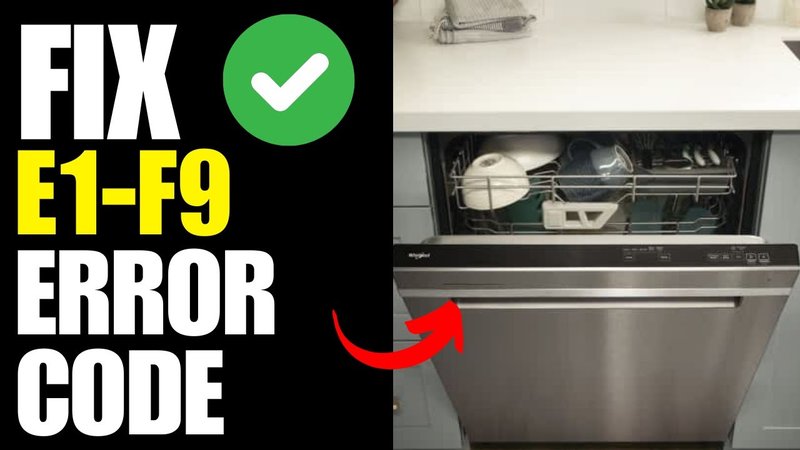
Now, you might be wondering, why does this error pop up, and how can we prevent it in the future? The E1 error mainly relates to issues with the water inlet system. This means the dishwasher isn’t filling up with water as it should, possibly because of a blocked water valve, a kinked hose, or even low water pressure. Understanding these basics can save you from a frustrating experience and make you the hero of your household’s kitchen duties.
Understanding the E1 Error Code
The E1 error code on your Whirlpool dishwasher is like a red flag waving in your face, telling you that the appliance is facing trouble with water intake. Think of it as the dishwasher’s way of saying, “Hey, I need a bit of water to get the job done, and I’m not getting it!” When your dishwasher shows E1, it’s primarily due to issues with the water coming into the machine.
Let’s break it down further: when you press ‘start’ on your dishwasher, it expects water to flow smoothly into its system through the inlet valve. If the dishwasher doesn’t detect enough water, either due to a trickle or no water at all, it will trigger the E1 error. This can happen due to a variety of reasons, such as a blocked or faulty inlet valve. The valve is like a gatekeeper at a party; if it doesn’t let guests (water) in, the party (cleaning process) can’t continue.
Additionally, the problem could be external. Picture the water hose as the pipeline delivering water to the dishwasher. If this hose is kinked, similar to a garden hose caught under a stone, it can’t deliver water properly, leading to the E1 error. Sometimes, low household water pressure can be the culprit. In these cases, ensuring consistent pressure through your home’s water supply can be key to preventing future issues.
Common Causes and Solutions for Error Code E1
So, what are the common culprits behind this annoying error code, and how can you tackle each one? Let’s start with the inlet valve. This tiny component is crucial for the dishwasher’s function. If it becomes clogged or defective, it’s like a faucet that’s been turned off. To address this, ensure the valve isn’t blocked by mineral buildup or debris by regularly inspecting and cleaning it.
Next on the list is the water hose. Imagine trying to drink from a straw that’s pinched; that’s exactly what happens if a dishwasher hose is kinked. Straightening the hose and checking for any pinches or blocks can often resolve the problem. Another less obvious issue could be the actual connectivity of this hose to the water source. Double-check that it’s securely attached to both the dishwasher and the water tap.
Finally, consider your home’s water pressure. If it’s too low, not enough water can flow into the dishwasher to fill it up. Think of this like watering your garden with a dribble rather than a steady stream—it just takes too long to get anywhere. Consult with a plumber if you suspect this might be the issue. They can suggest solutions to maintain adequate pressure throughout your plumbing system.
Preventative Tips for Avoiding Future E1 Errors
Now that you know what can cause these pesky E1 errors, preventing them becomes much easier. One of the easiest ways to ward off this error code is to regularly check and maintain the water inlet valve. Every few months, take a look inside; if you notice any buildup or grime, clean it promptly before it becomes a problem.
Another handy practice is to keep an eye on the water hose. Regularly check for any kinks and ensure the hose is running straight. Consider replacing the hose if it looks worn out or feels particularly brittle, as this could lead to kinks or cracks over time.
Lastly, be aware of your household’s water pressure. If members of your household frequently complain about weak water flow, or if faucets run slowly, these could be signs of a broader issue. Investing in a water pressure gauge can help you monitor this aspect closely. And, if necessary, consult a plumber to implement solutions that ensure your water pressure remains consistent and adequate.
By understanding what causes the E1 error and implementing these straightforward preventative measures, you can enjoy the convenience of your Whirlpool dishwasher without unexpected disruptions. In case these efforts don’t resolve the issue, don’t hesitate to contact a certified technician, because sometimes even the best efforts need a little professional backup.